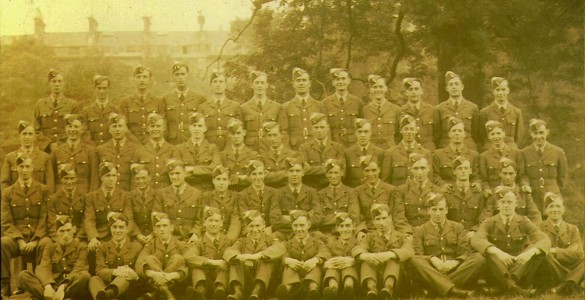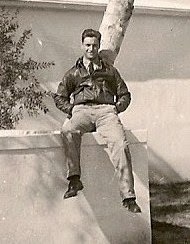Posted on November 19, 2015, 9:12 pm By John Proctor

From their same starting point at 9 ITW Stratford-on-Avon, Jim Ives and Ian Cunnison, pictured sitting next to each other (extreme right, second from front row), both went on to undertake their pilot training in the Southern States of the USA as members of Arnold Scheme class 42G. They both did their initial pilot training at Carlstrom Field, Arcadia, Florida and their basic at Gunter Field, Montgomery, Alabama, Jim then progressed to twin-engine advanced, Ian Cunnison remained with single-engine aircraft with the possible destination of RAF Fighter Command.
Despite starting from the same point, the ‘jobs’ pilots came to do were surprisingly varied, and, to use modern parlance – ‘random’. The RAF was made up of a myriad of Commands, Units, Squadrons, Special flights etc., etc., Jim went on to become a main force bomber pilot. After various training postings back in the UK Ian eventually found himself posted, in April 1944, to 1697 ADLS at RAF Hendon whence he operated until 9th May when the unit moved to RAF Northolt.
1697 Air Despatch Letter Service Flight was established in the run-up to ‘D-Day’ to deliver secret mail and equipment. After the landings their work included flights to the beach-head during the invasion period. 1697 ADLS operated Hurricanes fitted with under-wing storage housings or a detachable nose compartment to accommodate their cargo. The aircraft did not initially have the characteristic black and white ‘invasion’ wing stripes but after a couple of the Hurricanes were reputedly fired on by American fighters the livery was adopted.
One of 1697 Flight’s more famous pilots was Squadron Leader James Eric Storrar DFC* AFC who on 10th June 1944 flew the first Allied aircraft to land in France after ‘D’-Day, carrying classified mail and recording material for war correspondents (apparently Storrar’s take-off cry was ‘Fuel and noise – let’s go!’ ). Later that day F/Lt Stewart and F/Sgt Cunnison made the third successful trip to the beach-head, landing at advanced landing ground B3 at Sainte Croix-sur-Mer.
On 16th June 1679 Flight adopted the motto ‘ the Mail Goes Through’.
F/Sgt Cunnison’s association with 1679 Flight ended a month later on 16th July 1944, possibly as a result of a mishap on 3rd July when he suffered an engine failure on take-off – the incident apparently deposited his aircraft in the C/O’s garden.
After a short period at RAF Doncaster’s holding centre Ian Cunnison was moved via
5 Personnel Despatch Centre RAF Blackpool for a Transport Command posting to India, embarking on the troopship ‘Otranto’ for the four week voyage, disembarking at Bombay on 22nd September and on to 1944 Base Reception Depot Worli where supplies and personnel were received.
Newly arrived F/Sgt Cunnison’s first duty on the sub-continent was a fortnight’s course at the School of Jungle Survival at RAF Mahabaleshwar, a former hill station in the Western Ghats, Maharashtra, where the instructors were Kachins – Burmese hill-men who sought to pass on the multifarious aspects of jungle survival, basic local phrases, camouflage, field-craft, use of survival kits, recognition of snakes, spiders, scorpions etc., etc. ‘SJSPT M’swar’ was followed by a flying refresher course at No3 Refresher Flying Unit – Poona.
Then to 1331CU at Risalpur from the end of October until three days before Christmas 1944 – for conversion to various types – Hurricanes, Spitfire MkVIII, and Dakotas amongst others, in readiness for ferrying duties. From this point however, F/Sgt Cunnison’s health took a downward turn and he spent Christmas week in the B M Hospital Delhi but was fit enough to be posted to No 10 Ferry Unit, Nagpur on New Year’s Eve. He was again hospitalised locally at Kamptee in early February 1945 and then returned to B M Hospital, Delhi, briefly resuming duty at 10 FU at the end of May before being moved to the Convalescent Depot Chakrath and 59 Staging Post, Nagpur at the end of July where he spent VJ Day – and then on to the Invalids Depot, BRD (Base Reception Depot) Worli on 10th October 1945.
‘The luck of the draw’ had dealt Ian Cunnison a hand which he could not have expected, a wartime flying career far removed from that of the stereotypical bomber or fighter pilot.
| LAC Ian Cunnison at Carlstrom Field |
Ian Cunnison stayed on in the RAF after the war but later transferred to the Civil Service with whom he had a distinguished career.
No comments yet Categories: John Proctors Blog

